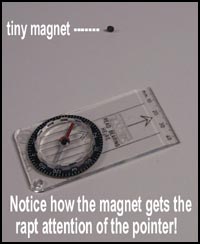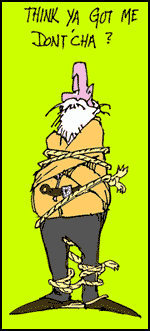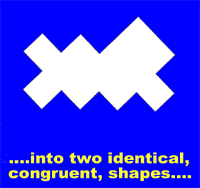 This Monday, we enter The Third Millennium. Now, that's only a calendar convenience, an assigned position from which a large percentage of the world's people reckon time. But it's worth noting, and I do so now. I want to thank all those folks who have not only supported our projects with kind words, but also invested in memberships and other methods of bringing us funds. I wish to all my best and very sincere good wishes for the New Year, the New Century, and the New Millennium. And I invite you to examine this web page for opportunities whereby you can provide support to the JREF as a means of celebrating the holiday. Love ya, need ya, and hope to meet more of you here or on my travels. Be safe, be happy, be prosperous.
This Monday, we enter The Third Millennium. Now, that's only a calendar convenience, an assigned position from which a large percentage of the world's people reckon time. But it's worth noting, and I do so now. I want to thank all those folks who have not only supported our projects with kind words, but also invested in memberships and other methods of bringing us funds. I wish to all my best and very sincere good wishes for the New Year, the New Century, and the New Millennium. And I invite you to examine this web page for opportunities whereby you can provide support to the JREF as a means of celebrating the holiday. Love ya, need ya, and hope to meet more of you here or on my travels. Be safe, be happy, be prosperous.
I thought you should see an excerpt from one letter that was sent at our instigation to the President's Committee on alternative/complimentary healing. I appealed here a couple of weeks back for letters pointing out the ill-advised choices of personnel in that group, and the response has been very rewarding. I think this writer has the right idea, and we share it here with you....
What distinguishes real medicine from "alternative medicine" is simply that real medicine works. Any time truly scientific procedures show that an "alternative" therapy really works, it loses its "alternative" status and becomes part of the normal body of medicine.
Fooling around with funding for vague claims and re-investigation of already-disproven claims of healing is a gross misuse of public funds that only appears momentarily politically advantageous because of the easily riled emotions of the critically ill in this country. I work in a hospital, and daily I see instances where well-proven precautionary diagnostic tests like EKGs cannot be administered because of the tightening of funding over the last five years. Medicine has had to become lean and mean, and I'm glad to say that my department — information technology — has contributed greatly to that move. In light of that, another pork barrel for such thoroughly disproven techniques as Therapeutic Touch and Acupuncture represents a complete abuse of the public trust.
Please, I urge you to use your position to reaffirm the government's firm support of solid medical science, and please turn the administration away from the charlatans who become rich from other people's misery, and the deluded individuals whose actions harm so many others.
Sincerely,
Matthew H. Fields
Dear Commission and Mr. President:
Medical Center Information Technology
University of Michigan Medical Center
Ann Arbor, Michigan
 More on the proposed Geller suit against Nintendo: Here is the "katakana" inscription beneath the Pokémon cartoon that Uri Geller says he is going to sue Nintendo over. Katakana is the Japanese system for expressing non-Japanese sounds. I asked a close friend, who is a Japanese national and works as an official interpreter for the United Nations, for her opinion of Uri Geller's claim that the word accompanying the "Abrakadabra" figure in the Japanese version says "Evil Geller" or "Young Geller." She verified that there is no katakana symbol for the "el" sound, and replied further:
More on the proposed Geller suit against Nintendo: Here is the "katakana" inscription beneath the Pokémon cartoon that Uri Geller says he is going to sue Nintendo over. Katakana is the Japanese system for expressing non-Japanese sounds. I asked a close friend, who is a Japanese national and works as an official interpreter for the United Nations, for her opinion of Uri Geller's claim that the word accompanying the "Abrakadabra" figure in the Japanese version says "Evil Geller" or "Young Geller." She verified that there is no katakana symbol for the "el" sound, and replied further:
"Not at all. [For the interpretation 'evil' or 'young'] it is not even close . . . There is no meaning of 'evil' here . . .The sound 'un' does not have any meaning together with 'geh-rur.' 'Un' is the sound we use independently, when we informally say 'yes' to someone very close."
I ask again, just where is the legal case that Geller thinks he has here?
Reader Scott Romanowski reminds me that he set up a special Foundation site for us at setiathome.ssl.berkeley.edu/stats/team/team_75256.html that has had great success. If you wish to become involved in the SETI project, as part of Team Randi, as we described here recently, please visit this site and get with it! Our group has already contributed 3.65 years of computer time to this project! Join us!
As promised, here's the how-to on the Stupid Old Moving-the-Compass Trick, as done by magicians. I don't recommend this as a party-piece, unless you go to The Dark Side and tell folks that it's not a trick, but a psychic wonder. It's really not much of a wonder of any sort, in my opinion. We used to do this one at summer camp as kids, and we sometimes fooled the new campers — for a little while. But parapsychologists and TV talk-show hosts will fall for this one, I'll bet.
A compass — the kind used to indicate direction — is simply a steel pointer balanced on a pivot and enclosed in a case so that it's safe from damage and other interfering forces such as wind. The pointer will swing to a north-south orientation (generally) because it's magnetized, and tends to line up with the natural magnetic field of the Earth. But it's very difficult to shield a compass pointer from external magnetic influences. The smallest bit of magnetic material brought into the vicinity of a compass will far overcome the Earth's field, and cause crazy readings. And therein lies the secret of the Stupid Old Moving-the-Compass Trick.
By secreting a small but powerful magnet in your hand, on your tie, taped to your knee, or perhaps in your shoe, you can make the pointer whip about or just glide in a small arc, depending on how close you are to it and how quickly you move. If you choose to conceal the secret magnet under your shirt or in your collar, sometimes you have to move in so close to the compass, that your face almost touches it! The big disadvantage, and almost a dead give-away of this trick, is that the compass pointer moves in direct response to the movement and the proximity of your body!
 The scrap of magnet can be very tiny, as you see in the photo. Recently, for a Korean TV videotaping, I used a piece of flesh-colored adhesive tape to conceal on my finger this pictured rare-earth magnet disc just 4.5mm by 1.6mm in size. (That's 3/16" by 1/16", for those of you who still use the archaic English System of Weights & Measures. That is to say, U.S. citizens, in opposition to all the rest of civilization.) Hey! Listen up! The first ten readers to get a stamped, self-addressed envelope to me at the JREF will receive a free tiny magnet, so they can become pseudo-psychics. One-time-only offer! Mark the envelope: pseudo-psychic secret magnet.
The scrap of magnet can be very tiny, as you see in the photo. Recently, for a Korean TV videotaping, I used a piece of flesh-colored adhesive tape to conceal on my finger this pictured rare-earth magnet disc just 4.5mm by 1.6mm in size. (That's 3/16" by 1/16", for those of you who still use the archaic English System of Weights & Measures. That is to say, U.S. citizens, in opposition to all the rest of civilization.) Hey! Listen up! The first ten readers to get a stamped, self-addressed envelope to me at the JREF will receive a free tiny magnet, so they can become pseudo-psychics. One-time-only offer! Mark the envelope: pseudo-psychic secret magnet.
If you have the opportunity to control conditions in the room where you'll perform the trick, an excellent method is to place a large loop of wire around the edge of the room, or around the edge of a floor-rug. Passing a moderate current through this loop — known in physics as a Hertzian coil — will produce a pulse of magnetism that will deflect the compass pointer, and if the pulse is triggered by an unseen helper just as you command the pointer to move, you have a minor miracle! Talking to a compass may make you look a bit nutty, but anyone who would actually believe that you've got magnetic powers, would also accept talking to a bit of metal and glass, I guess.
And, need I add, you should do just like the psychics do when they accomplish this wonder — by genuine psychic powers, of course, since they don't do tricks or even know how such a thing could be done. Sweat and grind your teeth, grunt and wheeze. That's what we call "showbiz." If they laugh at you, serves you right.
The socks-in-a-drawer puzzle got lots of you out there. The original problem, which has appeared in several puzzle-books, is stated thus: "You have to go into a dark room where there's a drawer containing five single black socks, and five single white socks. What's the minimum number of socks you have to remove from the drawer to have at least one matching pair, either black or white?"
The answer to that one is, of course, three. (BBB, WWW, BBW, WWB, so you always get a matching pair.) Adding one red sock, to that scenario, would provide you with the same answer — plus 1, to allow for the possibility that you might also select the single red sock — so the answer appears to be, four. But I asked a different question: "What's the minimum number of socks you have to remove from the drawer to have a 75% or better chance of having at least one pair?" That "75% or better" got some folks to start calculating whether three socks would still beat the requirements, or so they thought. But did you notice? I didn't say anything about the socks matching in color, so any selection of just two socks, and you'll have a "pair." Right? The answer is: two.
 I know I'll get a lot of arguments on this. So, let me put it a different way. "You have to go into a dark room where there's a drawer containing five single black wool socks, five single black cotton socks, and one black rayon sock. What's the minimum number of socks you have to remove from the drawer to have a 75% or better chance of having at least one pair?" Few would have a difficulty saying "two" in this case, because we're not so heavily inclined to match material as we are to match color. And, would a blind man, or a nerd with zero fashion sense, or just someone with cold feet — in the original statement, have any problem with it? It's very much like the old question, which I alter slightly here: "A Maori chief in New Zealand died of mysterious causes. Why did they bury him on the side of a hill?" Medical experts would demand to know the symptoms, anthropologists would examine the tribal customs, environmentalists would look into the impact on nature, and all would be misdirected by their particular field of expertise. They'd miss the simple answer: "Because he was dead."
I know I'll get a lot of arguments on this. So, let me put it a different way. "You have to go into a dark room where there's a drawer containing five single black wool socks, five single black cotton socks, and one black rayon sock. What's the minimum number of socks you have to remove from the drawer to have a 75% or better chance of having at least one pair?" Few would have a difficulty saying "two" in this case, because we're not so heavily inclined to match material as we are to match color. And, would a blind man, or a nerd with zero fashion sense, or just someone with cold feet — in the original statement, have any problem with it? It's very much like the old question, which I alter slightly here: "A Maori chief in New Zealand died of mysterious causes. Why did they bury him on the side of a hill?" Medical experts would demand to know the symptoms, anthropologists would examine the tribal customs, environmentalists would look into the impact on nature, and all would be misdirected by their particular field of expertise. They'd miss the simple answer: "Because he was dead."
The mathematical possibilities, the permutations and combinations, the percentages, all tended to mislead a good number of readers. And perhaps due to the seasonal distractions, we got far fewer responses this week. We usually receive 80 or more answers; this week, we only got 38! I kept a count, on this one. There were 10 "two" answers, from those of you who read very carefully, 12 "four" answers from those of you who didn't, and 16 who said "three" because they said that would beat the 75% requirement, if the socks had to match in color. Matt Fields, who regularly gets early answers in, was the first to come up with the correct answer, on the very first day.
What's the lesson here? As we try to show you, sometimes we're already familiar with a problem or situation, we conclude that what's now been presented is the same, or differs perhaps in just one respect, and we err thereby. Even the illustration that accompanied the puzzle, showing a pair of feet wearing one red sock and one black sock, with the caption, "Oops!" implied — but did not state — that what was shown would be a wrong situation.
Many years ago, when I operated a very good mirror-box illusion at an industrial show at the New York City Coliseum, several mechanical and electrical engineers who observed the exhibit developed complicated theories about how a dextrous apparently-mechanical hand was doing its performance in a display-case. Actually, that was my hand disguised in a metallic glove, and I was concealed behind mirrors, but these engineers, not expert in optics, believed that all their answers were to be discovered in mechanics and electricity. They postulated servomotors, relays, multi-track tapes, solenoids, even hydraulics, to produce very complex solutions — and they were very wrong. When I told them it was two mirrors at a right-angle, they simply shrugged and lost interest. People tend to think in their area of expertise — a very good reason why scientists are often  easily fooled by so-called psychics. The academics are not stupid or slow, just working with different tools. Magicians, on the other hand.......
We thank reader Brian K. Rafferty for his suggestion of this problem, and we insist that he also share the groans from those who were taken in.....!
easily fooled by so-called psychics. The academics are not stupid or slow, just working with different tools. Magicians, on the other hand.......
We thank reader Brian K. Rafferty for his suggestion of this problem, and we insist that he also share the groans from those who were taken in.....!
This week, it's a simple, yet elegant, puzzle. Use just one cut — or draw a line — and divide this white shape into two identical, congruent, parts. The line or cut need not be a straight one. And no, no giant pinking shears are allowed!
Till next century.....
